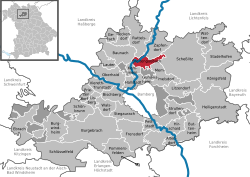Breitengüßbach
| Breitengüßbach | ||
|---|---|---|
|
||
| Coordinates: 49°53′30″N 10°53′30″E / 49.89167°N 10.89167°ECoordinates: 49°53′30″N 10°53′30″E / 49.89167°N 10.89167°E | ||
| Country | Germany | |
| State | Bavaria | |
| Admin. region | Oberfranken | |
| District | Bamberg | |
| Government | ||
| • Mayor | Reiner Hoffmann (UBB) | |
| Area | ||
| • Total | 16.86 km2 (6.51 sq mi) | |
| Elevation | 245 m (804 ft) | |
| Population (2015-12-31) | ||
| • Total | 4,513 | |
| • Density | 270/km2 (690/sq mi) | |
| Time zone | CET/CEST (UTC+1/+2) | |
| Postal codes | 96149 | |
| Dialling codes | 09544 | |
| Vehicle registration | BA | |
| Website | www |
|
Breitengüßbach (or Breitengüssbach) is a community in the Upper Franconian district of Bamberg. It was first mentioned as Gusibach and as belonging to the royal court at Hallstadt in an Imperial document issued between 812 and 830.
As to the name’s origin, there is no agreement. The Old High German word guza (“pour”) could refer to Gießbach, but since the neighbouring community of Hohengüßbach does not lie on a brook (Bach means “brook” in German), the name might also have come from the names Gosbert or Götz. The name in its current form crops up only in 1750, and only in the mid-19th century did it gain legal legitimacy.
After Breitengüßbach’s first mention as Gusibach in the early 9th century (about 812) and as being owned by the royal court at Hallstadt, Emperor Heinrich II donated the royal court along with Güßbach upon the founding of the Bishopric of Bamberg in 1007 to the Bamberg Church as the bishop’s demesne. Already by the first half of the 13th century, Breitengüßbach had its own House of God – St. Leonhard. In 1392, Güßbach was separated from the parish of Hallstadt and was granted its own parish rights.
The Güßbachers gave themselves a new village constitution in 1594, laying the basis for the community’s administration for centuries to come. The schoolmaster, the smith, the barber-surgeon, the herdsman and a midwife were hired and salaried by the community. The community’s own communal house, a community smithy and even a public bathhouse were all available in the community. In the Thirty Years' War, on 8 February 1633, half of Güßbach was left in rubble and ashes.
In 1750 came the first use of the name Breitengüßbach. Before Secularization, Breitengüßbach belonged to the High Monastery at Bamberg. Since the Reichsdeputationshauptschluss of 1803, the community has belonged to Bavaria. In the course of administrative reform in Bavaria, today’s community came into being under the Gemeindeedikt (“Community Edict”) of 1818.
...
Wikipedia



